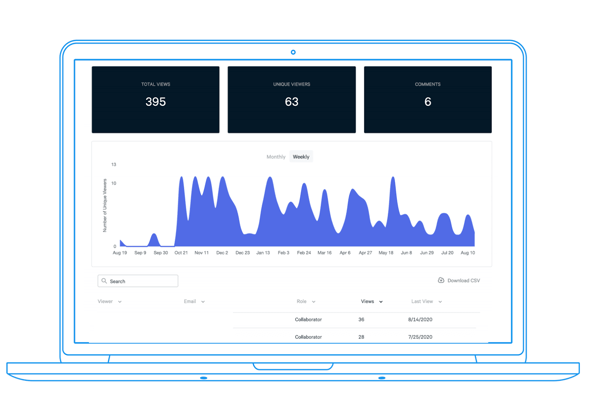Now that we’ve covered the basics of creating battlecards and walked through driving battlecard adoption in our Battlecards 101 series, it’s time to take the next step. By now, you’ve created and distributed your battlecards across your sales team. But, you can’t stop there, it’s the impact that really matters when it comes to competitive battlecards. You need to know how your battlecards are performing and how you can improve your battlecards to help your sales team increase competitive win rates and win more competitive deals. In this installment of Battlecards 101, we’re going to dig into measuring and optimizing your battlecards.
Battlecard Metrics to Measure
When it comes to metrics for your battlecards, the two focus areas are battlecard usage and battlecard impact. The usage numbers are important to measure how sticky your battlecards have become within your sales organization. Impact, in the form of competitive win rate, is important because it gives you insight into which battlecards are working and which ones aren’t, and allows you to analyze how you can fill in the gaps to optimize your battlecards.
Win more deals with these customizable battlecard templates >>
Battlecard Usage
First, you want to figure out how many of your sales reps are accessing your battlecards. Then you want to figure out which battlecards they’re accessing, and how frequently they’re accessing each battlecard.
To track battlecard usage, you can chat with your sales team to discover which battlecards they use. To make it even easier, the system in which you host your battlecards should be able to provide data about battlecard usage - which battlecards are being viewed, the frequency of battlecard use, and who’s viewing which battlecards.

Battlecard Impact
Next, you want to measure your battlecards’ impact on competitive win rates. While your overall win / loss rate considers all deals, we want to focus specifically on your competitive win rate, because battlecards are designed to help your sales team win more competitive deals. It’s no secret that prospects evaluate more than one product before making a final decision, so battlecards are critical for your sales team. To calculate your competitive win rate, divide the # of Won Opportunities by # of Total Opportunities, but only include deals where you went head-to-head with a competitor. If you’re not seeing a positive impact on your competitive win rate from your battlecards, you need to analyze them and optimize them for success.
How to Optimize Your Battlecards for Success
In addition to measuring usage and impact, you need to leverage those metrics to improve your battlecards. If you’re not seeing the impact you’d hoped, here are a couple of questions to ask yourself:
- How has your overall win rate increased or decreased since launching your battlecards?
- Which battlecards are being used most often? What about least often?
- Have your sales reps been caught blindsided, not able to locate competitor information on a battlecard? What’s missing on your battlecards?
- Have your sales reps been caught using out of date information?
- What is your sales team saying about the battlecards? Are they helping or hurting their sales process?
If your competitive win rate has increased, awesome! That’s exactly what we were hoping for. If your competitive win rate has remained the same or decreased, break it down by competitor to discover what the source of the decline is. If it’s increasing for some, but decreasing for certain competitors, take a look at the battlecard to see where you can improve.
Depending on which battlecards get used most often or least often, you can see which competitors you’re coming up against the most. To get optimal impact from your battlecards for the competitors you come up against most, ensure that you keep your battlecard information up to date and integrated into your sales workflow.
You can keep the information up to date by integrating automatically-updating tiles and refreshing the content periodically. You don’t want your sales reps to be blindsided by a competitive objection and not have the data to defend or back up claims. So when you’re adding intel into your competitive battlecards, be as thorough as possible. And remember to keep an open dialogue with your sales team about battlecards. Listen to what they say is working, and what might not be working for them.
Battlecard Elements to Optimize
Once you’ve measured and analyzed your battlecards, you may find a number of elements that need a refresh.
- New Competitor Intel: If you find new intel on a competitor that could help your sales team, add it into your battlecard. An example of this could be if your competitor updates their pricing model. Updated pricing can be extremely helpful to your reps, especially if a prospect is analyzing both your solution and your competitor’s.
- New Area of Competitive Intel: There may be different types of competitive intelligence that can be useful to your sales reps in competitive deals. Ask them what would be most useful, draw from requests you’ve gotten from them, or even learn from unique intelligence added to some but not all battlecards. For example, if you read about a new customer use case that your competitor is serving, this may be a relevant addition for your battlecard.
- New Competitor Within Your Market: This one is bigger than a tile addition, it’s a whole battlecard addition for an emerging competitor. If you come across an emerging competitor in your market, create a battlecard with the intel you’ve discovered. That way, if your sales rep hears about this competitor during the sales process, they’ll be armed and ready to tackle competitive objections.
You’re creating battlecards and other sales enablement materials to help your sales team be more efficient and bring in more revenue. So, if you can accurately measure usage and impact, and optimize your battlecards based on those metrics, you will be able to effectively enable your sales team to beat the competition.

Seeing is believing! Check out Crayon for yourself.
Take a Product TourRelated Blog Posts
Popular Posts
-
 The 8 Free Market Research Tools and Resources You Need to Know
The 8 Free Market Research Tools and Resources You Need to Know
-
 6 Competitive Advantage Examples From the Real World
6 Competitive Advantage Examples From the Real World
-
 How to Create a Competitive Matrix (Step-by-Step Guide With Examples + Free Templates)
How to Create a Competitive Matrix (Step-by-Step Guide With Examples + Free Templates)
-
 24 Questions to Consider for Your Next SWOT Analysis
24 Questions to Consider for Your Next SWOT Analysis
-
 How to Measure Product Launch Success: 12 KPIs You Should Be Tracking
How to Measure Product Launch Success: 12 KPIs You Should Be Tracking


